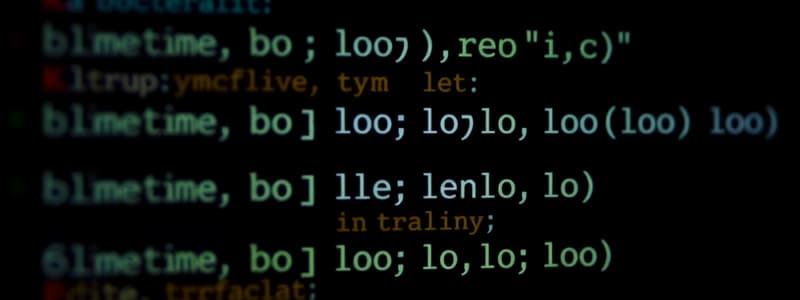Podcast
Questions and Answers
What is the correct syntax for a for loop?
What is the correct syntax for a for loop?
- for (condition; increment/decrement; initialization) { // code block }
- for (initialization; increment/decrement; condition) { // code block } (correct)
- for (initialization; condition; step) { // code block }
- for (initialization; condition; decrement/increment) { // code block }
Which of the following best describes a nested loop?
Which of the following best describes a nested loop?
- A loop that executes only once.
- A single loop that iterates through multiple variables.
- A loop inside another loop used for multi-dimensional data. (correct)
- A loop that creates an infinite execution scenario.
What is a common performance consideration when using nested loops?
What is a common performance consideration when using nested loops?
- They require no optimization techniques.
- They have a fixed performance no matter the data structure.
- They can lead to increased time complexity. (correct)
- They always execute faster than single loops.
Which of the following is NOT a common error in loops?
Which of the following is NOT a common error in loops?
What does the continue statement do in a loop?
What does the continue statement do in a loop?
Flashcards are hidden until you start studying
Study Notes
Loop Syntax
-
For Loop:
- Syntax:
for (initialization; condition; increment/decrement) { // code block } - Used for iterating over a sequence (like arrays).
- Syntax:
-
While Loop:
- Syntax:
while (condition) { // code block } - Executes as long as the condition is true.
- Syntax:
-
Do-While Loop:
- Syntax:
do { // code block } while (condition); - Executes the code block at least once, then checks the condition.
- Syntax:
Nested Loops
- Definition: A loop inside another loop.
- Use Cases: Useful for multi-dimensional data structures (e.g., matrices).
- Syntax:
- Example:
for (int i = 0; i < n; i++) { for (int j = 0; j < m; j++) { // code block } }
- Example:
- Performance Consideration: Can lead to increased time complexity; O(n*m) for two nested loops.
Loop Performance
- Time Complexity:
- For loops generally have predictable performance, while nested loops can multiply the complexity.
- Optimization Techniques:
- Minimize loop iterations.
- Use efficient data structures.
- Avoid unnecessary calculations within loops.
Common Errors In Loops
- Infinite Loops: Occurs when the loop condition never evaluates to false.
- Off-by-One Errors: Incorrectly setting loop boundaries, leading to missing or extra iterations.
- Variable Scoping Issues: Misunderstanding local vs global variables can lead to unexpected behavior.
- Modifying the Loop Variable: Changing the loop variable inside the loop can cause unpredictable results.
Loop Control Statements
-
Break:
- Exits the loop immediately.
- Commonly used to terminate a loop when a condition is met.
-
Continue:
- Skips the current iteration and proceeds to the next one.
- Useful for skipping specific conditions without exiting the loop.
-
Return:
- Exits from the current function, not just the loop.
-
Labels:
- Can be used to break or continue labeled loops, useful in nested loops for more control.
Loop Syntax
-
For Loop:
- Used for iterating over sequences, such as arrays.
- Format:
for (initialization; condition; increment/decrement) { // code block }
-
While Loop:
- Continues executing as long as the specified condition is true.
- Format:
while (condition) { // code block }
-
Do-While Loop:
- Guarantees at least one execution of the code block before checking the condition.
- Format:
do { // code block } while (condition);
Nested Loops
- Definition: A nested loop consists of one loop placed inside another loop.
- Use Cases: Particularly effective for handling multi-dimensional data structures such as matrices.
- Syntax Example:
for (int i = 0; i < n; i++) { for (int j = 0; j < m; j++) { // code block } } - Performance Consideration: Increased time complexity occurs with nested loops, often O(n*m) for two levels of nesting.
Loop Performance
-
Time Complexity:
- For loops exhibit predictable performance, whereas nested loops can significantly increase complexity.
-
Optimization Techniques:
- Reduce the number of loop iterations to enhance performance.
- Utilize more efficient data structures to improve access and modification speed.
- Avoid unnecessary calculations inside the loop to streamline execution.
Common Errors In Loops
-
Infinite Loops: Result from loop conditions that never reach false, leading to perpetual execution.
-
Off-by-One Errors: Arise from incorrectly set loop boundaries, causing iterations to be missed or repeated.
-
Variable Scoping Issues: Misunderstandings between local and global variables can lead to unexpected behaviors in loops.
-
Modifying the Loop Variable: Altering the loop variable within the loop can yield unpredictable outcomes and affect the loop's behavior.
Loop Control Statements
-
Break:
- Immediately exits the loop, often used when a specific condition is satisfied.
-
Continue:
- Skips the current iteration and jumps to the next iteration of the loop, allowing for selective processing.
-
Return:
- Ends execution of the current function, affecting the overall control flow, not just the loop.
-
Labels:
- Allow breaking or continuing labeled loops, providing enhanced control over nested loop structures for better manipulation.
Studying That Suits You
Use AI to generate personalized quizzes and flashcards to suit your learning preferences.




